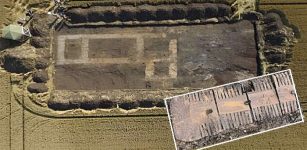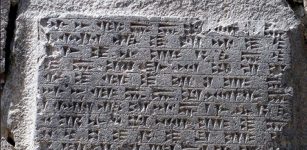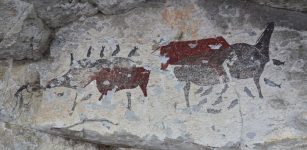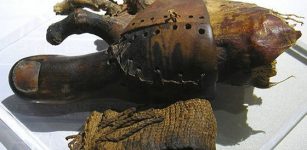Pharaoh Psusennes I Was Buried In The Silver Coffin Decorated With Gold
A. Sutherland - AncientPages.com - Tanis, an ancient area in Egypt's Nile Delta, was an early subject of the archaeologists' interest. The city's name was already well known as Soan (biblical Zoan).
Among many Tanis tombs, one belonged to Psusennes I, the third Pharaoh of the 21st Dynasty who ruled from Tanis between 1047 – 1001 BC.
Outer sarcophagus of the Egyptian King Psusennes' I. Credit: Jerzy Strzelecki - CC BY-SA 3.0
For more than five centuries, looters have plundered most graves of Egyptian pharaohs. One grave, however, was in some way miraculously omitted and it was the tomb of the so-called Silver Pharaoh enshrined in a silver coffin.
The name Psusennes is the Hellenized version, which in Greek means Pasibkhanu or Egyptian Hor-Pasebakhaenniut ("The Star Appearing in the City"), and his throne name was translated to" Great are the Manifestations of Ra, chosen of Amun." Psusennes I was the third king of the Twenty-first Dynasty and is probably the best known of all this Dynasty's kings.
In February 1939, the French archaeologist Pierre Montet (1885 – 1966) and his workers discovered an underground chamber blocked by a stone. It was a tomb consisting of four decorated limestone chambers containing sarcophagi belonging to Osorkon III and Prince Hornakht and the remnants of Takelot II's and Osorkon I's tombs.
In 1940, Montet and his workers continued the excavations at the ancient capital of Tanis and discovered one complete, undisturbed tomb.
Credit: Public Domain and Cairo Museum, Egypt - Compiled by AncientPages.com
The tomb belonged to the 21st Dynasty king Psusennes I and the tombs of the Pharaohs Osorkon I, Takelot II, Sheshonq III, and others in a royal necropolis atop Tanis.
The doorway of the Pharaoh's tomb was found tightly sealed, and in fact, when Montet discovered it, this took six days to shatter it. Finally, the tomb was entered by archaeologists who saw it was "filled with marvels of 1001 knights". It included both beautiful and valuable objects, but at first, there was no sign of any mummy or casket because they were sealed inside a huge stone sarcophagus.
From Psusennes' treasure: a lapis-lazuli necklace of King Psusennes, a 1,8 kg solid gold bracelet, a 8 kg solid gold necklace of Psusenne. Credit: Cairo Egyptian museum via Global Egyptian Museum
The sarcophagus - huge that it almost took all space in the chamber – was found sculpted and decorated with hieroglyphs. The sarcophagus' lid weighed halftone, and there was also additional stone sarcophagus within it, and it was beautifully carved, too.
The archaeologists worked hard additional six days to locate the inner casket finally. The chamber was opened by moving the door block of granite, and in a narrow room, there was enough space for a decorated coffin made of rose granite. At the feet of the sarcophagus stood a canopic jar, which contained the king's internal organs and vessels in gold and silver.
The king's body was covered with precious amulets and semiprecious stones.
Psusennes' mummy - destroyed due to Lower Egypt's moist location - was placed inside a coffin of silver, which was more valuable than gold as it had to be imported to Egypt.
The jewelry and other grave goods survived in perfect condition. The coffin was then placed in a black granite sarcophagus, which was in turn placed in a red granite outer sarcophagus.
Gold and lapis lazuli collar of Psusennes I, Cairo Museum. Credit: tutincommon (John Campana) - CC BY 2.0
Especially notable amongst the items discovered in the tomb was Psusennes' solid gold mask, which was found completely intact.
The mask – considered one of the treasure masterpieces - was made of gold and lapis lazuli and held inlays of black and white glass for the eyes and eyebrows of the object. It has a maximum width and height of 38 cm and 48 cm, respectively.
Archaeologists discovered that the Pharaoh's "fingers and toes had been encased in gold stalls, and he was buried with gold sandals on his feet. The finger stalls are the most elaborate ever found, with sculpted fingernails. Each finger wore an elaborate ring of gold and lapis lazuli or some other semiprecious stone.
The intact tomb of Pharaoh Psusennes I can only be compared to Tutankhamun's, and it testifies Psusennes I had a rich funeral.
Updated on February 12, 2022
Written by – A. Sutherland AncientPages.com Staff Writer
Copyright © AncientPages.com All rights reserved. This material may not be published, broadcast, rewritten or redistributed in whole or part without the express written permission of AncientPages.com
Expand for referencesMore From Ancient Pages
-
 Catherine De Medici – Queen Of France Supported Nostradamus, Was Suspected Of Poisoning And Blamed For Horrible Massacre
Featured Stories | Dec 17, 2018
Catherine De Medici – Queen Of France Supported Nostradamus, Was Suspected Of Poisoning And Blamed For Horrible Massacre
Featured Stories | Dec 17, 2018 -
 New Study: Fossils Reveal Human Ancestors’ Hearing Abilities
Human Beginnings | Sep 28, 2015
New Study: Fossils Reveal Human Ancestors’ Hearing Abilities
Human Beginnings | Sep 28, 2015 -
 Lincolnshire’s Prehistoric Henge And A Sacred Site Dating Back Hundreds Of Years
Archaeology | Apr 6, 2024
Lincolnshire’s Prehistoric Henge And A Sacred Site Dating Back Hundreds Of Years
Archaeology | Apr 6, 2024 -
 Geirrod: Giant That Tried To Kill God Thor But Was Killed Himself
Featured Stories | Sep 24, 2019
Geirrod: Giant That Tried To Kill God Thor But Was Killed Himself
Featured Stories | Sep 24, 2019 -
 DNA Reveals Unique Ancestry Of Inhabitants Of The Angolan Namib Desert
DNA | Oct 3, 2023
DNA Reveals Unique Ancestry Of Inhabitants Of The Angolan Namib Desert
DNA | Oct 3, 2023 -
 Major Discovery Of Ancient Roman Temple – Largest Evidence Ever Of The Imperial Cult
Archaeology | Jan 5, 2024
Major Discovery Of Ancient Roman Temple – Largest Evidence Ever Of The Imperial Cult
Archaeology | Jan 5, 2024 -
 On This Day In History: Battle of Champion Hill Was Crucial Action Of Grant’s Vicksburg Campaign – On May 16, 1863
News | May 16, 2016
On This Day In History: Battle of Champion Hill Was Crucial Action Of Grant’s Vicksburg Campaign – On May 16, 1863
News | May 16, 2016 -
 1,500-Year-Old Roman Settlement Destroyed By The Goths Discovered In Bulgaria
Archaeology | Mar 21, 2025
1,500-Year-Old Roman Settlement Destroyed By The Goths Discovered In Bulgaria
Archaeology | Mar 21, 2025 -
 Large Ancient Egyptian Astronomical Observatory In The Buto Temple Discovered In Kafr El-Sheikh, Nile Delta
Archaeology | Oct 9, 2024
Large Ancient Egyptian Astronomical Observatory In The Buto Temple Discovered In Kafr El-Sheikh, Nile Delta
Archaeology | Oct 9, 2024 -
 Ancient City Of Metsamor – Captured And Destroyed By Argishti I, The Ruler Of Urartu
Civilizations | Sep 11, 2015
Ancient City Of Metsamor – Captured And Destroyed By Argishti I, The Ruler Of Urartu
Civilizations | Sep 11, 2015 -
 Mystery Of The Horrible ‘Thing’ Found In A Dominican Monastery
Featured Stories | Sep 4, 2023
Mystery Of The Horrible ‘Thing’ Found In A Dominican Monastery
Featured Stories | Sep 4, 2023 -
 Why Did Socrates Drink Poison And Commit Suicide?
Ancient History Facts | Apr 21, 2018
Why Did Socrates Drink Poison And Commit Suicide?
Ancient History Facts | Apr 21, 2018 -
 Rare 1,400-Year-Old Temple Possibly Used By East Anglian Kings Discovered In Suffolk, UK
Archaeology | Nov 22, 2023
Rare 1,400-Year-Old Temple Possibly Used By East Anglian Kings Discovered In Suffolk, UK
Archaeology | Nov 22, 2023 -
 Bronze Age Royal Tombs Unearthed In Ruins Of Ancient City Of Pylos, Greece
Archaeology | Dec 30, 2019
Bronze Age Royal Tombs Unearthed In Ruins Of Ancient City Of Pylos, Greece
Archaeology | Dec 30, 2019 -
 Giant Balor Of The Evil Eye – Terrifying Fomorian King And Grandfather Of Celtic God Lugh
Celtic Mythology | Apr 30, 2018
Giant Balor Of The Evil Eye – Terrifying Fomorian King And Grandfather Of Celtic God Lugh
Celtic Mythology | Apr 30, 2018 -
 Unicorns In Southern Africa: The Fascinating Story Behind One-Horned Creatures In Rock Art
Featured Stories | Jun 24, 2023
Unicorns In Southern Africa: The Fascinating Story Behind One-Horned Creatures In Rock Art
Featured Stories | Jun 24, 2023 -
 Author’s Encounter With A Mysterious Not Of This World Entity Inside Callixtus Catacombs
Featured Stories | Apr 5, 2020
Author’s Encounter With A Mysterious Not Of This World Entity Inside Callixtus Catacombs
Featured Stories | Apr 5, 2020 -
 Ancient City Machu Picchu Was Originally Called Huayna Picchu By The Incas – Study Of The Name Reveals
Archaeology | Mar 23, 2022
Ancient City Machu Picchu Was Originally Called Huayna Picchu By The Incas – Study Of The Name Reveals
Archaeology | Mar 23, 2022 -
 What Can Medieval Skeletons Tell Us About Modern Day Pandemics
Archaeology | Feb 25, 2022
What Can Medieval Skeletons Tell Us About Modern Day Pandemics
Archaeology | Feb 25, 2022 -
 Prehistoric Evidence Of Sophisticated Prosthetics In Ancient Egypt – Artificial Toes Helped Egyptians Walk
Archaeology | Feb 20, 2014
Prehistoric Evidence Of Sophisticated Prosthetics In Ancient Egypt – Artificial Toes Helped Egyptians Walk
Archaeology | Feb 20, 2014




